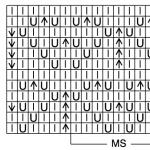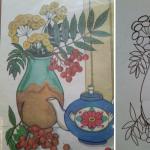Crochet jellyfish tops and T-shirts patterns. Crochet summer tunic with jellyfish pattern
Cardigan knitted in the round...

... crochet.
Size: S/M - M/L – XL
Required:
950-1050-1200 g of DROPS Silke-Alpaca yarn light gray-blue color (№ 6208)
hook 6 mm, or size suitable for the specified knitting density
2 buttons with a diameter of 2.5 cm
Knitting density: 3 circular rows = 6.5 cm. After the 5th row, the product should be approximately 20 cm in diameter.
The cardigan is knitted in the round.
The armholes begin in the 12th - 13th - 14th row, then 2 rows are knitted according to the description to form the armholes, then continue to knit according to the description for the circle.
Note 1: first st. from 2/n of each row, replace with 4 air. p., end each row with one connection. Art. to the beginning of the row.
Note 2: All measurements must be taken hanging, as the product will stretch when worn and the sleeves may become too long.
Circle: knit 4 air. p. and connect them into a ring, tying 1 connection. Art. in the first air P.
1st row: knit 8 tbsp. b/n in the ring.
3rd row: knit 1 tbsp. with 2/n, *3 air. p., skip 1 tbsp. with 2/n, 1 tbsp. from 2/n to the next st. with 2/n *, repeat between *-*, finish with 3 air. p., 1 connection Art. to the beginning of the row = 12 st. with 2/n.
4th row: knit 3 tbsp. with 2/n in the first st. with 2/n, *3 air. p., skip 3 air. p., 3 tbsp. from 2/n to the next st. with 2/n *, repeat between *-*, finish with 3 air. p., skip 1 tbsp. with 2/n, 1 connection Art. to the beginning of the row = 36 st. with 2/n.
5th row: knit 1 tbsp. with 2/n in each st. with 2/n and 3 tbsp. with 2/n in each arch from air. p. = 72 st. with 2/n. The size of the product is approximately 20 cm in diameter.
6th row: knit 1 tbsp. with 2/n in the first st. with 2/n, *3 air. p., skip 1 tbsp. with 2/n, 1 tbsp. from 2/n to the next st. with 2/n *, repeat between *-*, finish with 3 air. p., skip 1 tbsp. with 2/n, 1 connection Art. to the beginning of the row = 36 st. with 2/n.
7th row: knit 3 tbsp. with 2/n in the first st. with 2/n, *2 air. p., skip 3 air. p., 3 tbsp. from 2/n to the next st. with 2/n *, repeat between *-*, finish with 2 air. p., skip 3 air. p., 1 connection Art. to the beginning of the row = 108 st. with 2/n.
8th row: knit 1 tbsp. with 2/n in each st. with 2/n and 1 tbsp. with 2/n in each arch from air. p. = 144 st. with 2/n.
9th row: knit 1 tbsp. with 2/n in the first st. with 2/n, *3 air. p., skip 2 tbsp. with 2/n, 1 tbsp. from 2/n to the next st. with 2/n *, repeat between *-*, finish with 3 air. p., skip 2 tbsp. with 2/n, 1 connection Art. to the beginning of the row = 48 st. with 2/n.
10th row: knit 3 tbsp. with 2/n in the first st. with 2/n, *1 air. p., 3 tbsp. from 2/n to the next st. with 2/n *, repeat between *-*, finish with the 1st air. p., 1 connection Art. to the beginning of the row = 144 st. with 2/n.
11th row: 1 tbsp. with 2/n in each st. with 2/n and 1 tbsp. with 2/n in each arch from air. p. = 192 st. with 2/n.
12th row: *1 tbsp. with 2/n, 3 air. p., skip 2 tbsp. with 2/n *, repeat between *-* until the end of the row = 64 sts. with 2/n.
13th row: 3 tbsp. with 2/n in the first st. with 2/n, *2 air. p., 3 tbsp. from 2/n to the next st. with 2/n *, repeat between *-* = 192 st. with 2/n.
14th row: 1 tbsp. with 2/n in each st. with 2/n, 1 tbsp. with 2/n in each arch from air. p. = 256 st. with 2/n.
15th row: 1 tbsp. with 2/n in the first st. with 2/n, *3 air. p., skip 2 tbsp. with 2/n, 1 tbsp. from 2/n to the next st. from 2/n *, repeat between *-* until the end of the row = 86 sts. with 2/n.
16th row: 3 tbsp. with 2/n in the first st. with 2/n, *2 air. p., 2 tbsp. from 2/n to the next st. with 2/n, 2 air. p., 3 tbsp. from 2/n to the next st. from 2/n *, repeat between *-* until the end of the row = 215 sts. with 2/n.
Repeat the 14th, 15th and 16th rows with additions until the circle is 100-110-120 cm in diameter.
Formation of armholes:
Size S/M:
12th row: knit 1 tbsp. with 2/n, 26 air. p., skip 24 tbsp. with 2/n, *1 tbsp. with 2/n, 3 air. p., skip 2 tbsp. with 2/n *, repeat between *-* a total of 14 times, 1 tbsp. with 2/n, 26 air. p., skip 24 tbsp. with 2/n, *1 tbsp. with 2/n, 3 air. p., skip 2 tbsp. from 2/n *, repeat between *-* until the end of the row = 48 sts. with 2/n.
13th row: knit as follows: on 26 air. p. tie *3 tbsp. with 2/n, 2 air. n.*, 8 times in total. Next knit as follows: *3 tbsp. with 2/n in each st. with 2/n, 2 air. p.*, repeat between *-* = 192 st. with 2/n.
Continue knitting the 14th row according to the description given in the section above.
Size M/L:
13th row: 3 tbsp. with 2/n in the first st. from 2/n, 30 air. p., skip (1 tbsp. with 2/n, 3 air. p.) a total of 7 times, 3 tbsp. with 2/n in the next st., *2 air. p., 3 tbsp. from 2/n to the next st. with 2/n *, repeat between *-* a total of 15 times, 30 air. p., skip (1 st. with 2/n, 3 air. p.) a total of 7 times, * 2 air. p., 3 tbsp. from 2/n to the next st. from 2/n *, repeat between *-* until the end of the row = 150 sts. with 2/n.
14th row: knit as follows: 30 air. p. knit 28 tbsp. with 2/n. Next knit as follows: 1 tbsp. with 2/n in each st. with 2/n, 1 tbsp. with 2/n in each arch from air. p. = 256 st. with 2/n.
Continue knitting the 15th row according to the description given in the section above.
Size XL:
14th row: 34 air. p., skip (3 tbsp. with 2/n, 2 air. p.) a total of 8 times, * 1 tbsp. with 2/n in each of the next 3 sts. with 2/n, 1 tbsp. from 2/n to the next arch from air. p.*, repeat between *-* a total of 16 times, 34 air. p., skip (3 tbsp. with 2/n, 2 air. p.) a total of 8 times, * 1 tbsp. with 2/n in each of the next 3 sts. with 2/n, 1 tbsp. from 2/n to the next arch from air. p.* repeat between *-* until the end of the row = 192 sts. with 2/n.
15th row: knit as follows: on 34 chain stitches. tie *1 tbsp. with 2/n, 3 air. p.*, repeat between *-* a total of 11 times. Next knit as follows: 1 tbsp. with 2/n, *3 air. p., skip 2 tbsp. with 2/n, 1 tbsp. from 2/n to the next st. with 2/n *, finish 1 tbsp. from 2/n to the last st. with 2/n = 86 tbsp. with 2/n.
Continue knitting the 16th row according to the description given in the section above.
Sleeves: knit from the armhole and down, in circular rows. Remember Note 1!
Row 1: Work 52-60-68 sts. with 2/n along the edge of the armhole, finish 1 connection. Art. in the first st. with 2/n at the beginning of the row.
2nd row: knit 1 tbsp. with 2/n in the first st. with 2/n, *3 air. p., skip 3 tbsp. with 2/n, 1 tbsp. from 2/n to the next st. with 2/n * repeat between *-*, skip 3 tbsp. with 2/n, 1 connection Art. in the first st. with 2/n = 13-15-17 st. with 2/n.
3rd row: knit 2 tbsp. with 2/n in the first st. with 2/n, *1 air. p., skip 3 air. p., 2 tbsp. from 2/n to the next st. with 2/n * repeat between *-*, finish with 1 air. p. and 1 connection Art. to the beginning of the row = 26-30-34 sts. with 2/n.
4th row: knit 1 tbsp. with 2/n in each st. with 2/n and 2 tbsp. with 2/n in each air. p. = 52-60-68 st. with 2/n.
Crochet: work along the outer edge of the circle as follows: 1st row: 1 tbsp. with 2/n in the first st. with 2/n, *2 air. p., skip 3 tbsp. with 2/n, 1 tbsp. from 2/n to the next st. with 2/n *, repeat between *-*, finish with 2 air. p., 1 connection Art. in the first st. with 2/n.
2nd row: 2 tbsp. with 2/n in the first st. with 2/n, *4 air. p., 2 tbsp. with 2/n in the same st., 1 air. p., 2 tbsp. from 2/n to the next st. with 2/n *, repeat between *-*, finish with 4 air. p., 2 tbsp. with 2/n in the same st., 1 air. p. and 1 connection Art. in the first st. with 2/n. Cut the thread, hide the end of the thread.
Tying for buttons: tie 2 air. p., then 6 tbsp. b/n in the 2nd from the air hook. p., finish 1 connection. Art. in the first st. b/n (= 1st row).
2nd row: 1 air. p., knit 2 tbsp. b/n in each st. b/n and finish 1 connection. Art. in the first st. b/n at the beginning of the row (= 12 tbsp. b/n).
3rd and 4th rows: 1 air. p., knit 1 tbsp. b/n in each st. b/n and finish 1 connection. Art. in the first st. b/n at the beginning of the row (= 12 tbsp. b/n).
5th row: 1 air. p., knit 1 tbsp. b/n from every 2 next st. b/n and finish 1 connection. Art. in the first st. b/n at the beginning of the row (= 6 tbsp. b/n).
Insert a button inside, pull the end of the thread along the edge of the last row and pull tightly.
Put on the cardigan, adjust the location of the buttons on the left side of the cardigan and sew them to the penultimate row.
Amigurumi toys can decorate any interior; they look especially great in a nursery. Introducing the adorable amigurumi jellyfish crochet pattern. An original bright toy will bring life to the interior and will also become your baby’s favorite. If desired, the jellyfish can serve as a baby towel or washcloth. Depending on how the amigurumi jellyfish will be used, you should choose yarn for knitting.
The size of the finished product is from 38 to 45 cm in length, the jellyfish head is 12 cm in diameter. You can easily adjust the length of the tentacles, as well as their number. The amigurumi jellyfish crochet pattern was developed by ChiWei Rank, in the author's description you will find comments and useful tips. If you carefully follow all the instructions, the jellyfish will turn out neat and cheerful. We are waiting for photos of your amigurumi jellyfish in the comments to the post.
Funny jellyfish amigurumi
Patterns of crocheted toys
The knitting pattern has been translated into Russian by Handcraft Studio.
Materials
- hook 4 mm;
- cotton yarn: main color – 2 skeins, second color – 1 skein. For the blue jellyfish, two shades of blue were used, for the purple jellyfish - light purple and pink;
- safety eyes 9 mm;
- black floss threads;
- scissors;
- polystyrene filler.
Legend
conn. Art. – connecting post
VP - air loop
sc - single crochet
psn - half-column
dc - double crochet
* * – the repeat section is highlighted with asterisks
Head/face
Row 1: Knit 8 sc into an amigurumi ring. Conn. Art. in the first sc (8)
Row 5: ch 1, *1 sc in each. from the following 3 sc, increase* repeat until the end of the row. Conn. Art. in the first sc (40)
Row 6: ch 1, *1 sc in each. from the following 4 sc, increase* repeat until the end of the row. Conn. Art. in the first sc (48)
Rows 7-8: 1 ch, 1 sc in each. sc to the end of the row. Conn. Art. in the first sc (48)
Row 9: ch 1, *1 sc in each. from the following 5 sc, increase* repeat until the end of the row. Conn. Art. in the first sc (56)
Rows 10-14: 1 ch, 1 sc in each. sc to the end of the row. Conn. Art. in the first sc (56)
Row 15: ch 1, *1 sc in each. from the following 2 sc, decrease, 1 sc in next. sc, decrease* repeat until the end of the row. Conn. Art. in the first sc (40)
Fasten the thread and hide the ends.

Bottom of jellyfish
Row 1: ch 1, 8 sc in amigurumi ring. Conn. Art. in the first sc (8)
Row 2: ch 1, 2 sc in each. sc to the end of the row. Conn. Art. in the first sc (16)
Row 3: ch 1, * 1 sc in next row. sc, increase* repeat until the end of the row. Conn. Art. in the first sc (24)
Row 4: ch 1, *1 sc in each. from the following 2 sc, increase* repeat until the end of the row. Conn. Art. in the first sc (32)
Row 5: ch 1, *1 dc each. from the following 3 sc, increase* repeat until the end of the row. Conn. Art. in the first sc (40)
Fasten the thread, but leave the end long enough to make a connecting row of sc in a circle (about 60 cm).
Jellyfish tentacles
According to the author, the best tentacles are obtained using the freeform technique. They are all different from each other, but you can use one principle to make them look similar. You can link the pattern by this description amigurumi jellyfish to understand what each type of curl will look like. Additionally, you can change the hook number to get a different result. For the blue jellyfish, the author used a 4 mm hook, and for the purple one, a 5 mm hook. Each jellyfish has 8 tentacles of different widths and lengths.
Cast on a chain of 30, 40, 50, 60 or even 70 ch.
Work 2 (or 3) sc in each loop of the chain OR work 2 (or 3) hdc in each loop of the chain. If you are knitting sc, then start with the 2nd loop from the hook. If you knit a hdc, then start with the 3rd loop from the hook.
Choose your knitting method. Continue working sc or hdc, 2 or 3 each. loop to the end of the chain, fasten the thread, leaving the end.
If you adhere to one knitting principle (sc or hdc) for a sufficiently long segment, then you get the correct curl, then you can change the technique and you will get a different type of curl. Don't change the column type too often. You can style your curls or leave them as messy as you like!

Assembly
Step 1: Attach safety eyes between rows 12 and 13 with 8 sc between them.
Step 2: Use floss to embroider the mouth.
Step 3: Attach the tentacles to the bottom of the jellyfish by threading both ends of the threads through the holes between the posts and tying double knot. The ends will be hidden inside the filled jellyfish head.
Step 4: Line up the edges of the bottom of the jellyfish and its head. Connect the parts by tying them along the edge through all 4 walls of the loops (head and bottom panel) with single crochets.
Step 5: When you are almost all the way through, stuff the head, then continue sc to close the hole. Link connection Art. in the first sc. Fasten the thread and hide the ends.
If you want to hang the jellyfish, then sew a loop on the head. If not, then that’s it, the amigurumi jellyfish is ready!

Jellyfish shown in photo 1, we begin to knit with chains from 6th century. P ., which we close into a ring using conn. loops . Then we tie this chain using Art. with nak . according to scheme 1 below.
Scheme 1. Scheme of a seamless jellyfish, shown in photo 1.
The peculiarity of this model is that the entire jellyfish whole knitted , i.e., there is no need to break the thread to untie the tentacles. We “get” to the place where the tentacles are knitted using conn. loops, which is clearly visible in Scheme 1.

Photo 2. Jellyfish knitted according to pattern 2.
Medusa in photo 2 we start knitting with 4th century P ., which we close into a ring conn. loop . Then carefully knit according to pattern 2. Start knitting at point A.

Scheme 2. Crochet jellyfish. Diagram of the jellyfish shown in photo 2.
In diagram 2 you can see that the 5th row is 9 "arches" from 3rd centuryP ., with which the edge is tied domesjellyfish. Having thus reached point C, the thread can be broken and secured on the wrong side at point B in order to proceed to knitting jellyfish tentacle . From Diagram 2 it is clearly seen that each jellyfish tentacles is a chain of 10- 12th century P. which is tied conn. or "blind" loop . On the last V. P . we'll pull out the chains long loop and just leave it, go back to the last one V. P . chain and tie it around conn. loop. On to the next one jellyfish tentacle go from the wrong side domes with the help of the same conn. sang .

Photo 3. Jellyfish connected according to scheme 3.
To knit the jellyfish shown in photo 3, we will collect a chain of 5th century P. , which we close into a ring using conn. loops.

Scheme 3. Scheme of the jellyfish shown in photo 3.
To all of the above, it only remains to add that tentacles in this model the jellyfish are simply chain of 10-15 air loops , each of which (chain) is attached to the dome from the wrong side separately.

Photo 4. “Showy” jellyfish
"Showy" jellyfish in photo 4 it is made with two types of threads (melange and blue thread), which differ not only in color, but in thickness and texture (see photo 5).

Photo 5. Threads that were used to knit the “spectacular” jellyfish shown in photo 4
Consists of jellyfish, shown in photo 4, from several separately connected parts: domes And 2 types of tentacles (see photo 6)

Photo 6. Details of the “spectacular” jellyfish shown in photo 4
Jellyfish dome, made with melange thread, can be knitted according to one of the above patterns 1-3. I used scheme 2, with the difference that each "arch" of 3 V. I tied the item along the edge of the dome as follows:
1 tbsp. without nac., 1 tbsp. with nak., 1 tbsp. with 2 nak., 1 tbsp. with nak., 1 tbsp. without nac.
Then separately melange thread we knit big ones jellyfish tentacles, which represent 4 crochet spirals.
For those who have forgotten or simply don’t know, I’ll tell you how to knit spiral crochet:
we collect a chain of V. P . desired length and tie it Art. without nac. , or Art. with nak ., or Art. with 2, etc. yarn overs By 3 in each loop of the chain , due to which the chain twists into a spiral . Everything is very simple!
I’ll just add that for the tentacles I made a chain of 15-17th century P . and tied it around 3 tbsp. without nak . into each loop of the chain.
Thin tentacles tied by a thread of blue color and are simply chain of air loops b! Long threads are left at the beginning and end of the chain. The length of one chain should be such that when bent in half, the required length of one tentacle is obtained. Knitting one chain - obtained by bending 2 tentacles . In total it is enough to connect 3 chains of 50-60 c. P.
So all the details (photo 6) of our jellyfish are ready! All that remains is to sew them together with a needle and thread! A "spectacular" jellyfish depicted photo 4 is ready!!!
As the latest 5th model crochet jellyfish let's imagine little charming jellyfish related white mercerized thread "Lotus" "(100 g, 250 m, St. Petersburg) photo 7

Photo 7. Charming little jellyfish
The most amazing thing is that charming jellyfish in photo 7 it is seamlessly knitted, that is, it can be knitted from start to finish without tearing off the thread.
Let's start knitting our charming jellyfish from below with 3 tentacles. You've probably already noticed that tentacles connected spiral crochet . Above it was described in detail how to knit crochet spiral I’ll just add that in this case I typed a chain of 13.c. P . and tied her up Art. without nac. By 3 into each loop of the chain. Having reached the end of the chain, we do not break the thread, but collect a new chain from 13th century P., we tie it, then we knit the 3rd tentacle.
Tying in this way 3rd tentacles , we also do not break the thread, but knit again a chain of 7-8 c. P., but with the goal of rising to the top domes our future jellyfish. I hope that intermediate photo 8 will help you understand the principle of further knitting of our jellyfish.

Photo 8. Charming jellyfish, seamlessly knitted, the dome is turned inside out
The last one air loop we will consider the chains as the center and top jellyfish domes .
Let's tie this last loop 4 tbsp. without nak . Then we knit in a circle in a downward spiral, knitting in the next circle in 2 tbsp. without nak . in each loop of the previous row. In the next round it is enough to add 2-3 c. P . and knit 2-3 rows before starting to knit the fields.
Fields knit like this: do 2nd century p.p. and knit according 2 tbsp. with nak . in each loop of the previous row. We close the beginning and end of the circle conn. loop . Our jellyfish's dome is ready! All ours are ready adorable little white jellyfish !!!







